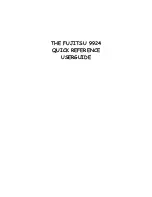
FCC
Statement
This
equipment
has
been
tested
and
found
to
comply
with
the
limits
for
a
Class
B
digital
device,
pursuant
to
part
15
of
FCC
Rules.
These
limits
are
designed
to
provide
reasonable
protection
against
harmful
interference
in
a
residential
installation.
This
equipment
generates
and
can
radiate
radio
frequency
energy
and,
if
not
installed
and
used
in
accordance
with
the
instructions,
may
cause
harmful
interference
to
radio
communications.
However,
there
is
no
guarantee
that
interference
will
not
occur
in
a
particular
installation.
If
this
equipment
does
cause
harmful
interference
to
radio
or
television
reception,
which
can
be
determined
by
turning
the
equipment
off
and
on,
the
user
is
encouraged
to
try
to
correct
The
interference
by
one
or
more
of
the
following
measures:
Reorient
or
relocate
the
receiving
antenna.
Increase
the
separation
between
the
equipment
and
receiver.
Connect
the
equipment
into
an
outlet
on
a
circuit
different
from
that
to
which
the
receiver
is
connected.
Consult
the
dealer
or
an
experienced
radio/TV
technician
for
help.
This
device
complies
with
Part
15
of
FCC
Rules.
Operation
is
subject
to
the
following
two
conditions:
This
device
may
not
cause
harmful
interference,
and
this
device
must
accept
any
interference
received,
including
interference
that
may
cause
undesired
operation.
Note:
The
manufacturer
is
not
responsible
for
any
radio
or
TV
interference
caused
by
unauthorized
modifications
to
this
equipment.
Such
modifications
could
void
the
user’s
authority
to
operate
this
equipment.
When
only
use
MID
by
portable
meet
FCC
RF
Exposure
Information
(FCC
SAR)
The
Device
meets
the
government’s
requirements
for
exposure
to
radio
waves.
The
device
I
designed
and
manufactured
not
to
exceed
the
emission
limits
for
exposure
to
radio
frequency
(RF)
energy
set
by
the
Federal
Communication
Commission
of
the
U.S.
Government.
The
exposure
standard
for
wireless
mobile
devices
employs
a
unit
of
measurement
knows
as
the
Specific
Absorption
Rate,
or
SAR.
The
SAR
limit
set
by
the
FCC
is
1.6W/Kg.
Tests
for
SAR
are
conducted
using
standard
operating
positions
accepted
by
the
FCC
with
the
device
transmitting
at
its
highest
certificated
power
level
in
all
tested
frequency
bands.
Although
the
SAR
is
determined
at
the
highest
certificated
power
level,
the
actual
SAR
level
of
the
device
while
operating
can
be
well
below
the
maximum
value.
This
is
because
the
device
is
designed
to
operate
at
multiple
power
levels
so
as
to
use
only
the
poser
required
to
reach
the
network.
In
general,
the
closer
you
are
to
a
wireless
base
station
antenna,
the
lower
the
power
output.
While
there
may
be
difference
between
the
SAR
values
levels
of
various
devices
and
at
various
positions,
they
all
meet
the
government
requirement.
Summary of Contents for MA7
Page 1: ...TELPAD MA7 Android 4 4 Jellybean 1 6GHz Quad Core Processor Infrared Function ...
Page 6: ...1 GETTING STARTED ...
Page 8: ...2 TELPAD INTRODUCTION ...
Page 17: ...3 TABLET FUNCTIONS ...
Page 69: ...64 4 And then press Cast screen same as figure two below Figure 1 2 ...
Page 87: ...4 THE CONNECTION BETWEEN DOCK PHONE AND TABLE ...
Page 93: ...5 BASIC TROUBLESHOOTING FOR THE TELPAD ...
Page 95: ...6 FAQs ...
Page 101: ...7 WARNINGS AND PRECAUTIONS ...
Page 106: ...8 PERSONAL INFORMATION AND DATA SECURITY ...
Page 108: ...9 LEGAL NOTICE ...
Page 110: ...10 DISCLAIMER OF WARRANTIES ...
Page 112: ...11 INDEX ...
Page 113: ...108 ...
Page 114: ...109 ...
Page 115: ...Warranty card NAME TEL NO ADDRESS DATE OF PURCHASE VERSION SERIAL NO 110 ...

































